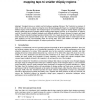Free Online Productivity Tools
i2Speak
i2Symbol
i2OCR
iTex2Img
iWeb2Print
iWeb2Shot
i2Type
iPdf2Split
iPdf2Merge
i2Bopomofo
i2Arabic
i2Style
i2Image
i2PDF
iLatex2Rtf
Sci2ools
BEHAVIOURIT
2005
2005
TouchGrid: Touchpad pointing by recursively mapping taps to smaller display regions
Touchpad devices are widely used but lacking in pointing efficiency. The TouchGrid, an instance of what we term cell cursors, replaces moving the cursor through dragging the finger on a touchpad with tapping in different regions of the touchpad. The touchpad regions are recursively mapped to smaller display regions and thereby enable high-precision pointing without requiring high tapping precision. In an experiment, six subjects used the TouchGrid and a standard touchpad across different numbers of targets, distances to targets, and target widths. Whereas standard touchpad operation follows Fitts' law, target selection time with the TouchGrid is a linear function of the required number of taps. The TouchGrid was significantly faster for small targets and for tasks requiring one tap, and marginally faster for two-tap tasks. Error rates tended to be higher with the TouchGrid than the standard touchpad. All subjects preferred the TouchGrid.
| Added | 15 Dec 2010 |
| Updated | 15 Dec 2010 |
| Type | Journal |
| Year | 2005 |
| Where | BEHAVIOURIT |
| Authors | Morten Hertzum, Kasper Hornbæk |
Comments (0)

